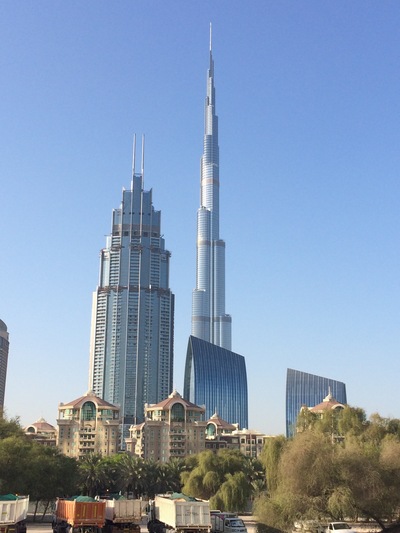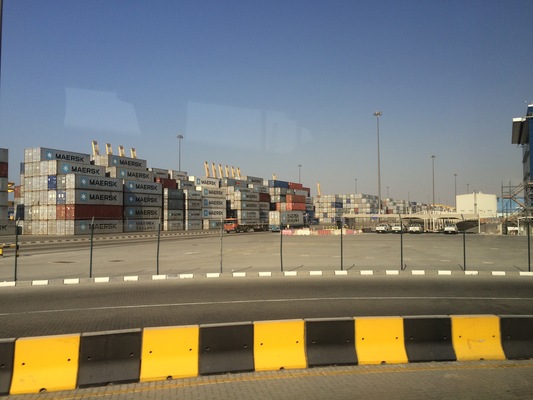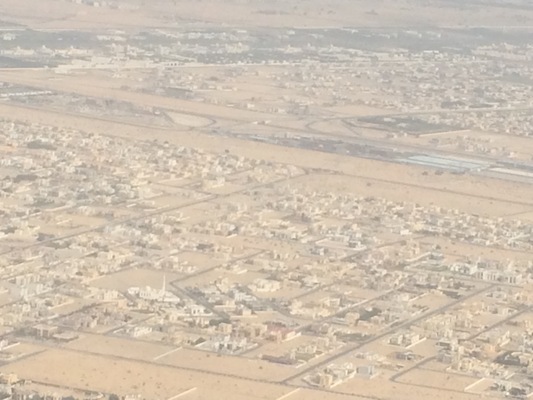- Dubai is the most visible global face of the United Arab Emirates’ (UAE) successful economic transformation.
- Despite strong economic development, the UAE’s leadership has recognized the need to achieve more balanced growth. An initiative such as Vision 2021, which emphasizes the knowledge economy, is one such example.
- In meeting with firms, the UAE most stands out for the quality of its management teams; comparing management practices in the UAE versus those in the larger and better-known Chinese market provides an intriguing contrast.
- Like companies in China, the majority of UAE companies originated from the state. The UAE companies are distinguished by the fact that they are now managed by truly professional teams that utilize developed market best practices – a positive harbinger for long-term investment prospects.
I took off from Dubai International Airport on my return flight to San Francisco with a sense of wonder. I was struggling to reconcile the spectacular view of the desert framed by the airplane’s window with the content of my meetings in Dubai. A vast landscape of sand devoid of meaning was juxtaposed against very fruitful meetings with regional companies. Myriad thoughts circled in my mind as they eventually settled on one parallel experience: China.
The United Arab Emirates (which includes Dubai as one of seven emirates) and China have each experienced their own version of an economic miracle over past decades, at the expense of living with unbalanced economies. Gross domestic product (GDP) per capita in the UAE exceeds $40,000,1 placing it in the upper echelons of the world ranking; China is now the world’s second largest economy with GDP of $11 trillion in 2015.2 The economic development models followed by these two countries have resulted in skewed economies: in 2015 the UAE’s crude and natural gas extraction sector, including its related industries, accounted for 46% of GDP,3 while China’s gross fixed capital formation (investment in infrastructure as well as property, plant and equipment) accounted for 44% of GDP.4 To address these imbalances, the UAE has adopted a plan named “Vision 2021” to transition toward a “knowledge economy,” while China is attempting to grow consumer spending faster than GDP so as to reduce its reliance on gross fixed capital formation to drive growth.
Despite these countries representing two successful cases of economic transformation, China has dominated the attention of global financial markets. There is good reason for this narrow focus, as China offers a much larger economy, and consequently a greater opportunity set. The table below compares the number and market capitalization of companies domiciled in the UAE with those domiciled in China/Hong Kong.
| United Arab Emirates | China / Hong Kong | |||
|---|---|---|---|---|
| Number of Companies | Market Capitalization (USD billion) | Number of Companies | Market Capitalization (USD billion) | |
| Consumer Discretionary | 3 | 4 | 635 | 1,380 |
| Consumer Staples | 2 | 1 | 237 | 559 |
| Energy | 3 | 2 | 91 | 570 |
| Financials | 27 | 90 | 138 | 2,270 |
| Health Care | 3 | 4 | 273 | 575 |
| Industrials | 10 | 20 | 883 | 1,933 |
| Information Technology | - | - | 530 | 1,590 |
| Materials | 2 | 1 | 569 | 941 |
| Other | - | - | 50 | 86 |
| Real Estate | 10 | 35 | 297 | 857 |
| Telecommunication Services | 2 | 51 | 19 | 348 |
| Utilities | 1 | 1 | 124 | 441 |
| Total | 63 | 210 | 3,846 | 11,551 |
- Includes companies with a market capitalization equal to or higher than $250 million.
- Sources: Bloomberg, Seafarer. Data as of December 2, 2016.
My motivation for writing this field note, however, is not to exhaustively compare and contrast the two countries, but to highlight a subtler difference between listed companies in the two markets that, in my opinion, will make a difference to investor returns going forward.
That difference is management. The management teams of the great majority of companies I met with in Dubai consist of foreign professionals with experience grounded in developed market practices (85% of the UAE’s population is foreign nationals). By contrast, China has a different spectrum of management teams, from government bureaucrats in charge of state-owned enterprises (SOEs) to competent entrepreneurs that have thrived in spite of the obstacles imposed by government-related interests.
From a bottom-up investment perspective, these differences matter in a way that a top-down approach would fail to appreciate. The top-down approach to investing in emerging markets would simply account for the fact that MSCI upgraded the UAE from a Frontier Market to an Emerging Market, effective June 2014. In similar fashion, a top-down investor would anticipate the likely inclusion of Chinese A-shares in the MSCI Emerging Markets Index at some point in the future. While a pragmatic method for deriving investment returns, this approach fails to consider the true source of returns in the long term.
Seafarer’s investment discipline, however, relies on stock-specific research, which is where our own assessment of management becomes critical. One of the keys to long-term investment returns is management’s capital allocation decisions. This is the area that gave me the most comfort during my meetings in Dubai. It is also the issue I struggle with most in my meetings with Chinese corporate management teams.
Based on many interviews with management teams, my experience has been that, when asked about future capital expenditures, most Chinese SOEs tend to follow themes defined by Beijing’s ever-present five-year plans. When asked what returns these investments are expected to generate, the figure invariably settles on 10%. Digging for further details around this figure and its accompanying capital structure, it becomes clear that these answers have a pre-determined feel to them. Indeed, it is impossible for all investments in the country to generate the same return, much less prove successful.
Thus, I find it interesting that China’s SOE reform process includes improving the incentive structure. It remains to be seen whether this element of reform will translate to improved capital allocation at the company level. I have mentioned in past notes (such as my Field Notes from Beijing) that several of the SOEs Seafarer has met with have added employees and outside strategic investors to their shareholder base. Yet, despite this change, there seems to be no obvious change in the way decisions are made. One example of this phenomenon is a SOE operating in the food packaging industry. After explaining how its future capital expenditure plan was incrementally more market-driven and partially related to a new private shareholder, management proceeded to note that this plan was awaiting approval from its controlling shareholder, a state entity with many other unrelated holdings. In other words, despite superficial changes to the incentive structure, decision-making at this company was still not autonomous.
I found another expression of this idea in a Chinese liquor company. This proved to be a very difficult investment case with regard to how much weight to apportion to the interests of the controlling shareholder and consequent implications for future returns of capital. This company relies on an archaic operating structure, leaving ample room for improvement on what is already a profitable business. As was the case with the previous example, the company introduced new strategic partners and employees as shareholders. The problem, however, is that its ultimate controller remains unchanged and its motivations unclear. I had the distinct sense that this controller was more concerned with maintaining its interest in what it knows is a profitable business than in transforming it. Put another way, while a business may have great potential to deliver returns over the short or medium term, long-term returns will always be capped by a controller with interests that differ from those of minority investors. Sometimes, one must consciously forgo short- to medium-term investment returns to avoid the risk of misaligned interests in the shareholding structure, which may find expression as surprise negative corporate actions in the short-term and capped returns in the long-term.
To me, the unresolved question concerning China’s SOE reform process is whether it will eventually prove to be cosmetic change devoid of substance. After these and other meetings, I have the distinct sense that China is importing market and corporate structures from developed markets in the belief that these are now necessary and appropriate to continue propelling the economy, given its present stage of development, while allowing Beijing to maintain control. From my outside opinion, what Beijing may be overlooking is that these operating structures are the result of a constant process of discovery at the individual level by developed market entrepreneurs; they were not imposed from the top. I wonder if imposing these structures in China by fiat on managers not accustomed to taking decisions at the individual level will yield the desired results.
Contrast this experience with that of the UAE. Like China, the UAE has developed with heavy intervention by the state, but the implementation could not be more different. For reasons that fall outside the scope of this note, the country has essentially imported all of its labor. As a result, even if the controlling shareholder of many companies is the state, management teams tend to be professionals instead of bureaucrats, and they bring with them years of experience based on developed market best practices, instead of decades of policy implementation under a command economy. The difference is palpable during a meeting.
One particularly pleasing case is that of a small industrial company that is still recovering from the aftermath of the 2008 financial crisis, which disproportionately affected the UAE given its reliance on oil exports. Not only was management extremely clear and direct regarding how it has reformed its operations since the crisis, but its articulation of the long-term reinvestment versus capital return potential of the company was well grounded and detailed. Furthermore, the controlling shareholder (a state-related entity) has proven through its actions since 2008 to have the interest of minority shareholders front of mind. In the aftermath of 2008, instead of recapitalizing the company on the cheap and wiping out the existing shareholder base, the company’s controller chose to purchase convertible bonds from the company. This approach gave the company time to recapitalize itself through future cash flow generation. Furthermore, this entity is currently partially buying back those convertible bonds, thus minimizing shareholder dilution. The controlling shareholder wants to maintain a public float and is interested in the share price performance as demonstrated by the re-instatement of a dividend. These are not the actions of a state-related entity acting for its own benefit alone, but rather the actions of a controlling shareholder interested in the benefit of all shareholders.
Another case where I gained great comfort with the long-term use of capital is that of a trade-related multinational based in Dubai. This company is creating a global footprint, like many Chinese SOEs, but management’s attention to the price paid for assets, as well as its evaluation of associated long-term returns, is on a level I’ve rarely encountered in China.
The above impressions are based on anecdotal observations, and therefore they might not represent the market as a whole; nevertheless, the caliber of management in the UAE resonated with me as a long-term investor. Listed equities in the UAE may suffer from neglect in global emerging market portfolios partially due to the fact that the UAE has fewer and smaller investment opportunities than other markets. But for bottom-up investors like Seafarer, the market distinguishes itself on the general quality of management. The value of this managerial difference should not be overlooked.
Paul EspinosaDubai




- The views and information discussed in this commentary are as of the date of publication, are subject to change, and may not reflect the writer’s current views. The views expressed represent an assessment of market conditions at a specific point in time, are opinions only and should not be relied upon as investment advice regarding a particular investment or markets in general. Such information does not constitute a recommendation to buy or sell specific securities or investment vehicles. It should not be assumed that any investment will be profitable or will equal the performance of the portfolios or any securities or any sectors mentioned herein. The subject matter contained herein has been derived from several sources believed to be reliable and accurate at the time of compilation. Seafarer does not accept any liability for losses either direct or consequential caused by the use of this information.
- Source: The World Bank.
- Source: The World Bank.
- Source: United Arab Emirates Ministry of Economy, “The Annual Economic Report 2015,” 2015.
- Source: The World Bank.
![[Chrome]](/_layout/images/ua/chrome.png)
![[Firefox]](/_layout/images/ua/firefox.png)
![[Opera]](/_layout/images/ua/opera.png)
![[Microsoft Edge]](/_layout/images/ua/edge.png)